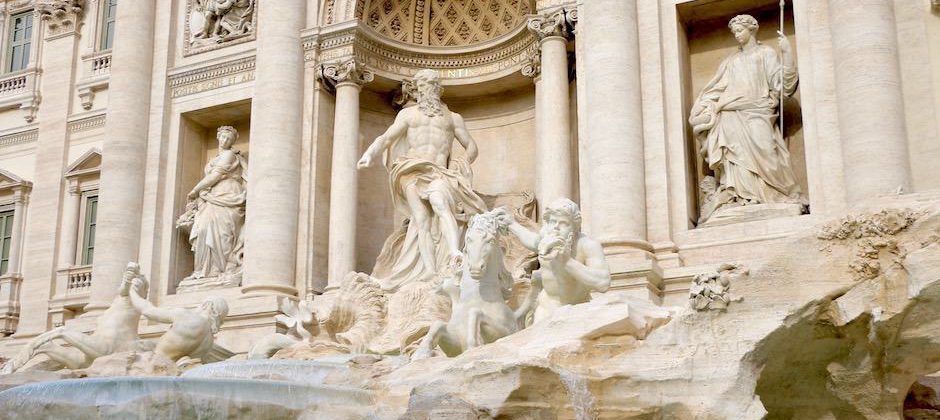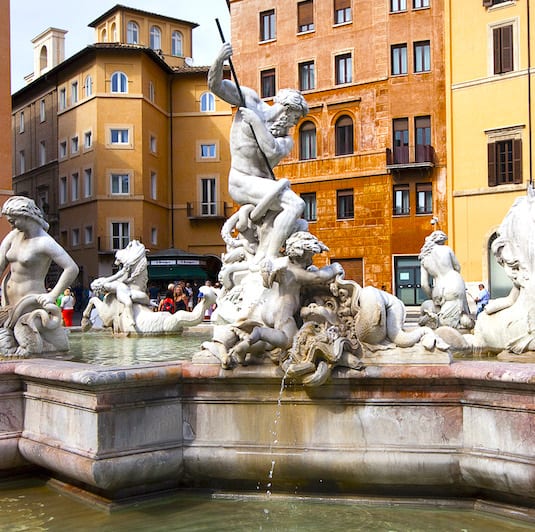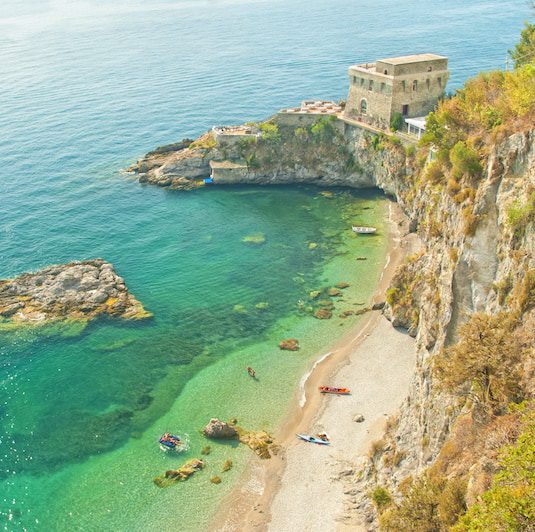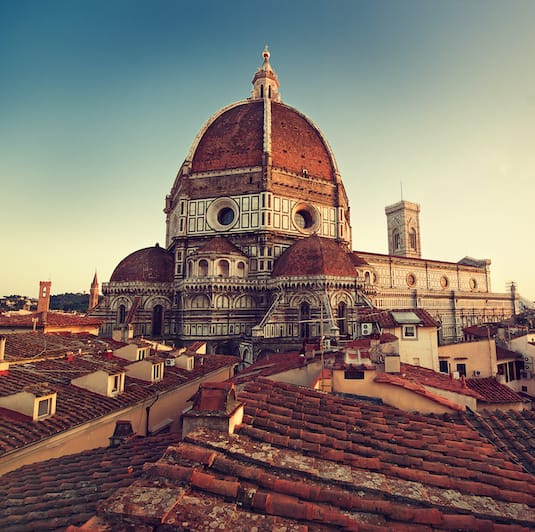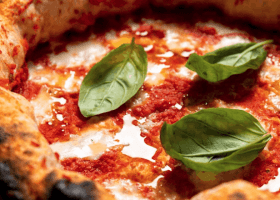Planning to see Trevi Fountain on your trip to Rome and unsure what else to see in the area? No problem! The Eternal City is full of treasures hidden in plain sight. In this article, we’ll guide you to the top things to see near Trevi Fountain.
Pro Tip: Bookmark this article in a “Rome” folder in your browser, so you can circle back to it while planning. Check out our best Rome tours so you can see the Eternal City as few others do. Also, see our guide to Rome for more resources to help you plan your trip.
What To See Near Trevi Fountain
Trevi Fountain is a baroque icon that sees an average of between 1,000 to 1,200 visitors per hour most years. It’s easy to snap a pic, throw your coins in the fountain, and go—but you found this article, which means you’re a savvy traveler who wants more. Here are the top things to see at Trevi Fountain including historical info and insider details.
9. Giardini del Quirinale
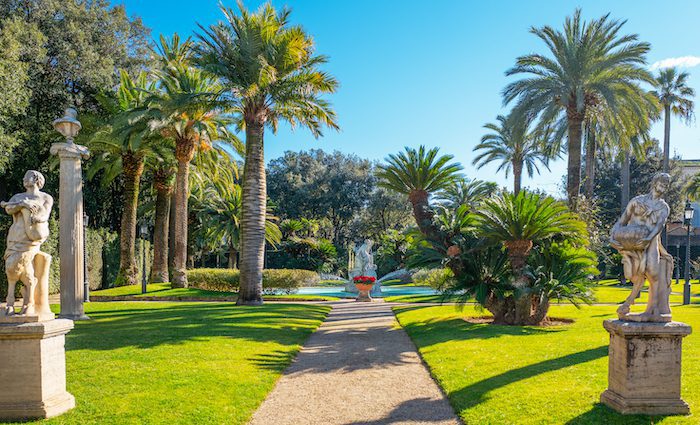
Looking for a good place to stroll around and get a coffee? Or somewhere elegant to let your kids run around without the worry of vehicle traffic? The Quirinale Gardens provide you with four acres of lush green space in the middle of Rome. The gardens are free to enter, quite beautiful, and rarely used—a lovely place for a moment of peace surrounded by the charms of Rome.
Address: P.za del Quirinale
8. Palazzo Barberini and the Helicoidal Staircase
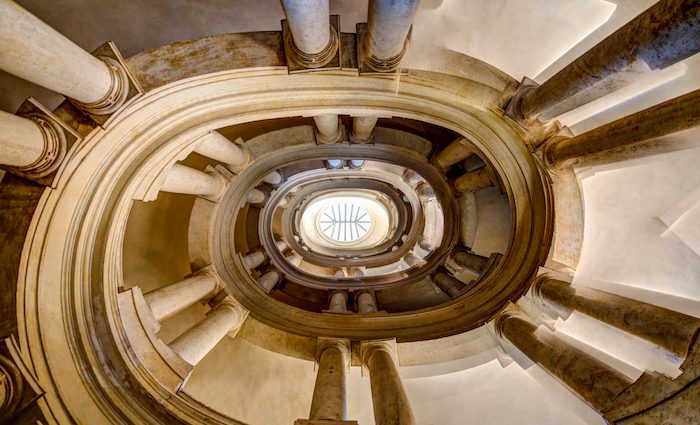
Palazzo Barberini is one of Rome’s great art galleries that almost nobody visits. If it were in any other city, it would be one of the greatest museums you’d find. It has a lot of competition in Rome for the attention of art lovers, so its corridors remain empty. This may sound sad, but it’s good news if you go and visit it—you’ll have an amazing gallery to yourself!
What is there to see in the gallery? For starters, Borromini’s Helicoidal Staircase. It is one of the most beautiful displays of architecture and ingenuity you’ll ever see. As polished as a sculpture, this staircase was born out of resentment. Yes, resentment.
Borromini worked under Stefano Moderno in the design of the Barberini Palace. When Moderno died, he thought he would be chosen as the new lead architect. Instead, the commission went to Bernini and a blood feud was born.
Borromini was left with a staircase assignment and he gave it 150% to show he was the master. Today, it is the crowning jewel of the Palazzo. You can also see works by Caravaggio and Raphael here, another reason to put it at the top of your list of museums to visit.
Address: Via delle Quattro Fontane, 13
7. Via del Corso Shopping

Near Trevi Fountain is the spine of Rome, Via del Corso. This road has been there since the times of Ancient Rome, although I’m sure it has been refinished a few hundred times! The original name of the road was Via Lata that was eventually changed to Via del Corso. Why?
The name means “Road of the Race,” which comes from a horse race that took place every year in Rome called Corsa dei Barberi. However, this wasn’t the kind of horse race we would think of today. In this annual celebration, horses would race without riders. Eventually, they changed the name to Via del Corso because it was the Road of the Race.
Today, the bottom half of this road has some vehicle traffic, but the top half is mostly pedestrian with lots of great shopping. While nearby Via Condotti has expensive stores and designer brands, Via del Corso is dotted with more affordable brands like Zara.
Address: Via del Corso
6. Aqua Virgo Aqueduct
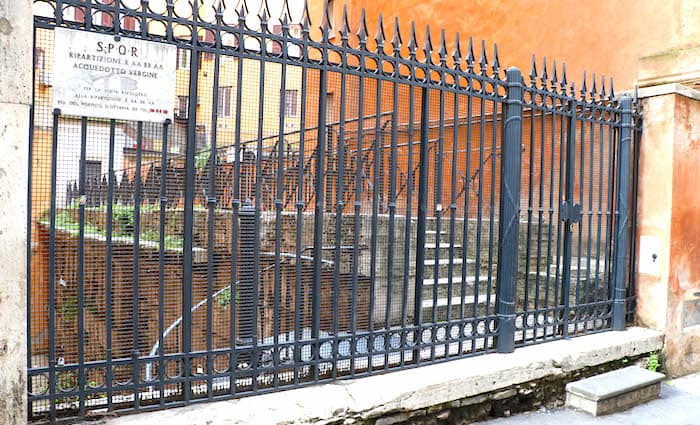
Aqua Virgo Aqueduct is one of Rome’s oldest aqueducts and it feeds the Trevi Fountain today, over 2,000 years after its original construction. Just around the corner from Trevi Fountain, you can see parts of the conduits bringing water to it. You’ll find it in a small alley with a metal fence protecting it and a plaque that reads: “Acuedotto Vergine.”
Unfortunately, there’s not much else to see from this vantage point. It’s pretty cool to get a view of the inner workings of the water system though. This is a great stop to hit on your way to the Trevi Fountain from the Spanish Steps on your self-guided walking tour.
Pro Tip: Looking for the aqueduct you can explore called Vicus Caprarius or Water City? Keep reading—it’s #2.
Address: Via del Nazareno, 9a
Popular Rome Tours
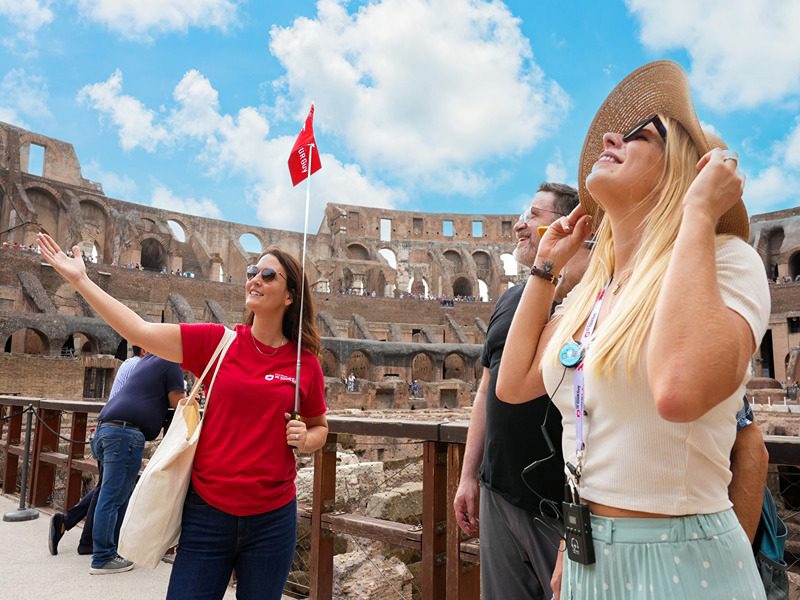
Best-Selling Tour
Rome in a Day Tour with Colosseum and Vatican Museums
Seeing the best of Rome in a single day might seem like a big undertaking, but our expertly designed tour makes it effortless with skip-the-line tickets, included transportation, and engaging guides to lead the way. In just 7 hours, you’ll visit renowned sites like the Sistine Chapel, Colosseum, Trevi Fountain, and Pantheon. With fascinating stories at every stop, you can skip the stress and immerse yourself in the vibrant heritage and culture of Rome all in one remarkable day.
See Prices
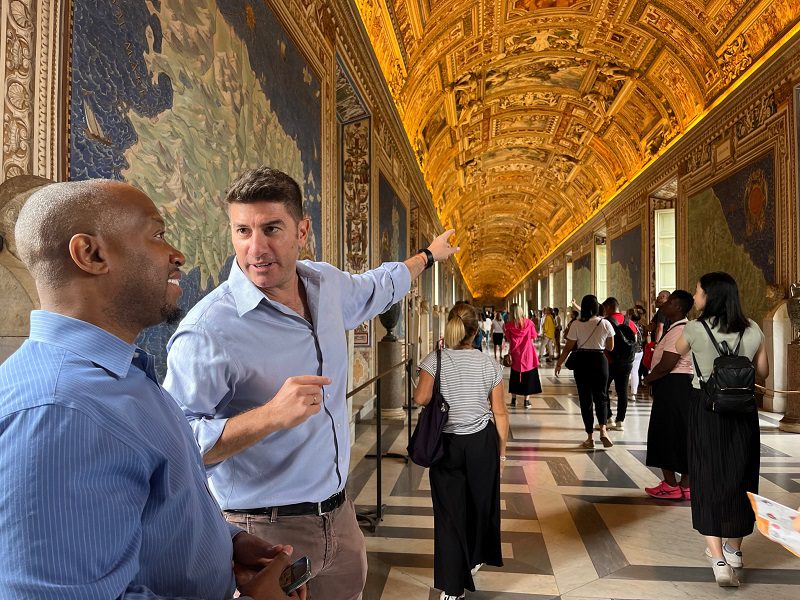
Best Price!
Privileged Entrance Vatican Tour with Sistine Chapel
Without the right access, visiting the Vatican means fighting crowds, long waits, and missing the most significant rooms and works of art. Our privileged entrance tour offers more than just entry—it’s an immersive experience led by a storytelling guide who brings the Vatican to life. Skip the line and explore the Vatican Museums, including the Raphael Rooms and the Sistine Chapel, with engaging insights that make each moment memorable and meaningful.
See Prices
Not ready to book a tour? Check out our Rome Guide for more info.
5. Basilica di Sant’Andrea delle Fratte
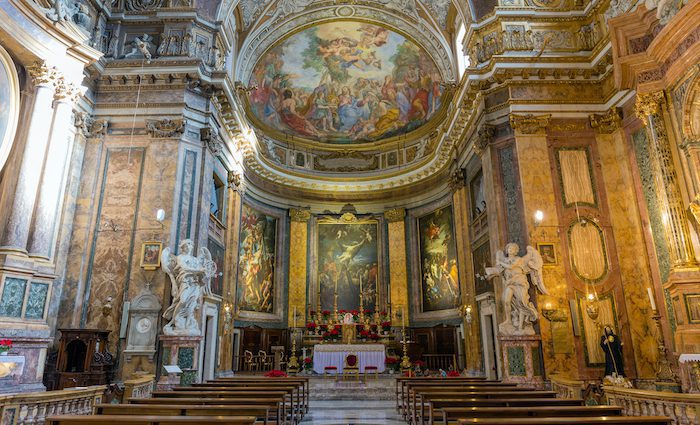
The Basilica di Sant’Andrea delle Fratte is a perfect stop if you are coming from the direction of the Spanish Steps. The church is diagonally opposite the plaque on the outside of Gian Lorenzo Bernini’s residence and it contains some of this work.
Many people pay for admission tickets to see exceptional art, paintings, and sculptures from masters like Bernini without ever realizing how easy it is to see so much of it for free. In this church, you can see two angels on the left and right of the alter both created by Bernini. Most churches close for a long lunch, so be sure to come in the morning or late afternoon.
Address: Via di Sant’Andrea delle Fratte, 1
4. Column of Marcus Aurelius
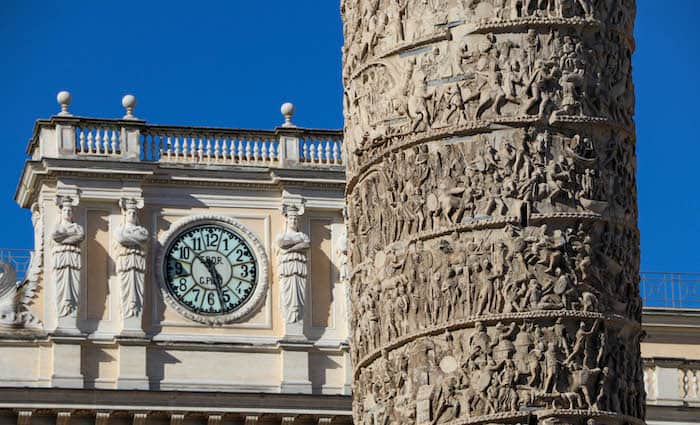
Modeled after Trajan’s column built less than a century prior, the Column of Marcus Aurelius is a victory column that details Rome’s triumph over the Sarmatians, Quadi, and Marcomanni in A.D. 176. The column itself was likely completed around A.D. 193 after Marcus Aurelius’ death.
It stands a total of 130 feet tall and was made from Carrara marble. Made from 28 in total, the blocks were hollowed out and placed to form a 200-step staircase leading to a top platform.
This column, along with Trajan’s, paints a very detailed picture for historians to connect the dots of past events. Our fear, and likely reality, is that propaganda and exaggerations in these works may alter how history is written, but that is the way of the world It is certainly better to have it than not.
This incredible monument that has survived almost 2,000 years and, in any other city, would be a main attraction. Here in Rome, however, it goes almost unnoticed.
Address: P.za Colonna
3. Piccolo Buco
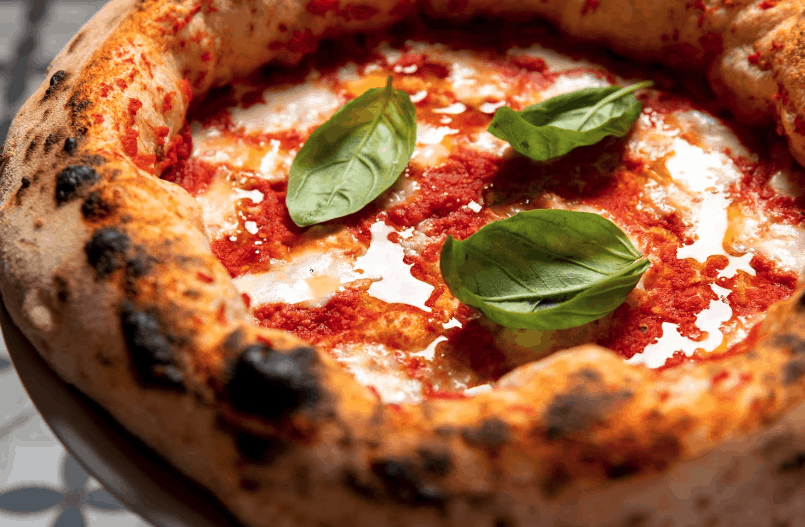
€€ | Casual | Kid Friendly
Food is always part of the journey, which is why we run food tours in every city we operate in. The name of this restaurant means the “small hole”, similar to the English saying, “hole in the wall.” The pizza here, however, is anything but.
They cook their pizza in an oven that is over a hundred years old, and apparently they don’t make pizza ovens like they used to! I don’t know why that is important, but it always is. The owners are actually from the Trevi Fountain area (a rarity because nobody lives there) and have saved us all from tourist-trap armageddon.
This is my number one Trevi Fountain pick for a great cheap meal. The style of pizza is Napoletano, not Roman, which may be misguided. That said, come here for the pizza, it’s the best!
Address: Via del Lavatore, 91
2. Find Trevi Fountain’s Water Source: Vicus Caprarius

In-City Underground Ruins | Interactive | €
Did you know you can explore the underground water source for Trevi Fountain (and other ancient Roman buildings)? Yep! While the Trevi Fountain teems with hoards of people above, you could head to a quiet street for a reserved entrance to the Vicus Caprarius, the Water City.
The archaeological ruins here were once an apartment complex from the height of the Roman era. During an excavation, the still-running water source was found and preserved so you can explore yourself! It’s a cool spot that has lots of informational videos and catwalks to explore the water tanks from several angles. On display are also amazing artifacts from clay pots to mosaics.
You have to reserve your spot ahead of time—don’t wait until you arrive! The tickets are €8 but you can also request a guided tour in English or Italian.
Address: Vicolo del Puttarello, 25
1. Trevi Fountain: Baroque Masterpiece
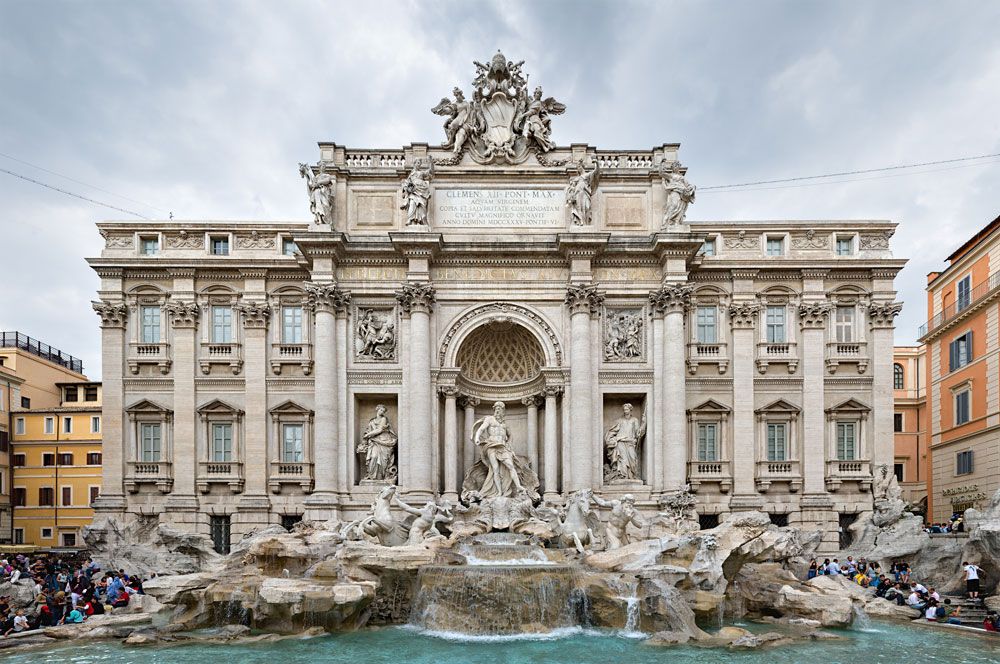
The word “Trevi” refers to the small piazza where the fountain is located and the three roads meet. Tre means three in Italian and via means road or street, and this is how we get Tre-via or Trevi. Fontana di Trev, then, is the fountain of three roads.
The backdrop of the fountain is the facade of Palazzo Poli, a museum housing engravings and other important artefacts. In the 17th century, Gian Lorenzo Bernini set out to build Trevi Fountain but the plan never went through. Over a hundred years later, Nicola Salvi got the commission by losing a competition for best drawing.
Salvi lost the competition to a Florentine, Alessandro Galli. Romans were not happy about a Florentine getting the commission and revolted. Eventually, Salvi was handed the job. Construction began in 1732 and was completed in 1762, 11 years after Salvi’s death. The architect Giuseppe Pannini took over and worked with multiple sculptors to finish the project. Find out more about the symbolism, stories, and folklore surrounding the Trevi Fountain.
Not ready to book a tour? Check out our Rome Guide for more info.
Next Stop…
If you’re doing a walking tour of Rome, your next stop should be the Pantheon since it is so close to Trevi Fountain. We show you how to do a DIY walking tour of Rome in the video below or see the DIY Rome itinerary. Hungry? Check out the best restaurants near Trevi Fountain.
Not ready to book a tour? Check out our Rome Guide for more info.
Here’s Where To Stay in Italy’s Most Popular Destinations
Rome, Florence, Venice, Amalfi Coast, and Capri

